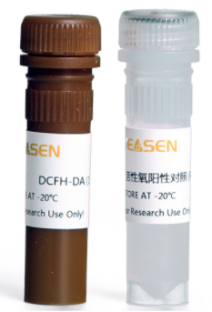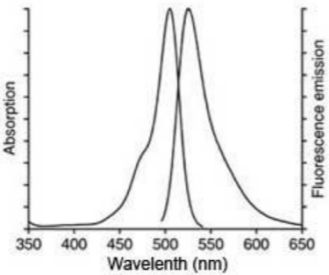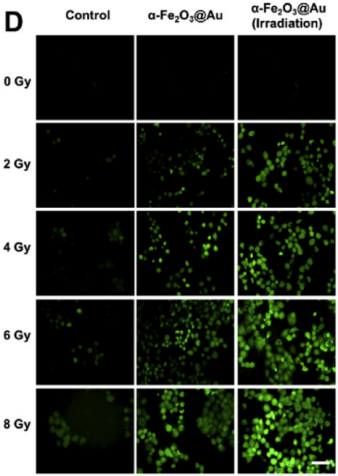【1】Zhang M, et al. Conscription of Immune Cells by Light-Activatable Silencing NK-Derived Exosome (LASNEO)
for Synergetic Tumor Eradication. Adv Sci (Weinh).2022 Aug;9(22): e2201135. doi: 10.1002/advs.202201135.
Epub 2022 Jun 4. PMID: 35665496; PMCID: PMC9353410. IF: 16.806
【2】Zhang D, et al. Microalgae-based oral microcarriers for gut microbiota homeostasis and intestinal protection
in cancer radiotherapy. Nat Commun. 2022 Mar 17;13(1):1413. doi: 10.1038/s41467-022-28744-4. PMID: 35301299;
PMCID: PMC8931093. IF: 14.919
【3】Jiao D, et al. Biocompatible reduced graphene oxide stimulated BMSCs induce acceleration of bone remodeling
and orthodontic tooth movement through promotion on osteoclastogenesis and angiogenesis. Bioact Mater. 2022
Feb 6; 15:409-425. doi: 10.1016/j.bioactmat.2022.01.021. PMID: 35386350;PMCID: PMC8958387. IF: 14.593
【4】Guo G, et al. Space-Selective Chemodynamic Therapy of CuFe5O8 Nanocubes for Implant-Related Infections.
ACS Nano. 2020 Oct 27;14(10):13391-13405. doi: 10.1021/acsnano.0c05255. Epub 2020 Sep 22. PMID:32931252.
IF: 14.588
【5】Yang C, et al. Red Phosphorus Decorated TiO2 Nanorod Mediated Photodynamic and Photothermal Therapy
for Renal Cell Carcinoma. Small. 2021 Jul;17(30): e2101837. doi: 10.1002/smll.202101837. Epub 2021 Jun 19.
PMID: 34145768. IF:13.281
【6】Xiaolu Chen, et al. Metal-phenolic networks-encapsulated cascade amplification delivery nanoparticles
overcoming cancer drug resistance via combined starvation/chemodynamic/chemo therapy. Chemical Engineering
Journal. 2022 Aug; 442:136221. IF: 13.273
【7】Hao Ding, et al. Mesenchymal stem cells encapsulated in a reactive oxygen species-scavenging and O2-
generating injectable hydrogel for myocardial infarction treatment. Chemical Engineering Journal. 2022.133511:1385-
8947. (doi.org/10.1016/j.cej.2021.133511)IF: 13.273
【8】Yu H, et al. Triple cascade nanocatalyst with laser-activatable O2 supply and photothermal enhancement for
effective catalytic therapy against hypoxic tumor. Biomaterials. 2022 Jan; 280:121308. doi: 10.1016/j.biomaterials.
2021.121308. Epub 2021 Dec 8. PMID: 34896860. IF: 12.479
【9】Sun D, et al. A cyclodextrin-based nanoformulation achieves co-delivery of ginsenoside Rg3 and quercetin
for chemo-immunotherapy in colorectal cancer. Acta Pharm Sin B. 2022 Jan;12(1):378-393. doi: 10.1016/j.apsb.2021.
06.005. Epub 2021 Jun 18. PMID: 35127393;PMCID: PMC8799998. IF: 11.614
【10】Xiong Y, et al. Tumor-specific activatable biopolymer nanoparticles stabilized by hydroxyethyl starch prodrug
for self-amplified cooperative cancer therapy. Theranostics. 2022 Jan 1;12(2):944-962. doi: 10.7150/thno.67572. PMID:
34976222; PMCID: PMC8692913. IF: 11.556
【11】Gao J, et al. Mitochondrion-targeted supramolecular "nano-boat" simultaneously inhibiting dual energy
metabolism for tumorselective and synergistic chemo-radiotherapy. Theranostics. 2022 Jan 1;12(3):1286-1302. doi: 10.
7150/thno.67543. PMID: 35154487; PMCID:PMC8771563. IF: 11.556
【12】Zhong D, et al. Calcium phosphate engineered photosynthetic microalgae to combat hypoxic-tumor by in-situ
modulating hypoxia and cascade radio-phototherapy. Theranostics. 2021 Jan 22;11(8):3580-3594. doi: 10.7150/thno.55441.
PMID: 33664849; PMCID: PMC7914342. IF: 11.556
【13】Sun J, et al. Cytotoxicity of stabilized/solidified municipal solid waste incineration fly ash. J Hazard Mater.
2022 Feb 15;424(Pt A):127369. doi: 10.1016/j.jhazmat.2021.127369. Epub 2021 Sep 29. PMID: 34879564. IF: 10.588
【14】Zhu C, et al. Multifunctional thermo-sensitive hydrogel for modulating the microenvironment in Osteoarthritis by
polarizing macrophages and scavenging RONS. J Nanobiotechnology. 2022 May 7;20(1):221. doi: 10.1186/s12951-022-01422-9. PMID: 35526013; PMCID: PMC9077879. IF: 10.435
【15】P15an X, et al. Zinc oxide nanosphere for hydrogen sulfide scavenging and ferroptosis of colorectal cancer. J
Nanobiotechnology.2021 Nov 27;19(1):392. doi: 10.1186/s12951-021-01069-y. PMID: 34838036; PMCID: PMC8626909. IF: 10.435
【16】He J, et al. Gold-silver nanoshells promote wound healing from drug-resistant bacteria infection and enable
monitoring via surface-enhanced Raman scattering imaging. Biomaterials. 2020 Mar;234:119763. doi: 10.1016/j.
biomaterials.2020.119763. Epub 2020 Jan 8. PMID: 31978871. IF: 10.317
【17】Cheng Q, et al. Nanotherapeutics interfere with cellular redox homeostasis for highly improved photodynamic
therapy. Biomaterials. 2019 Dec;224:119500. doi: 10.1016/j.biomaterials.2019.119500. Epub 2019 Sep 17. PMID: 31557591.
IF: 10.273
【18】Zhong D, et al. Laser-triggered aggregated cubic α-Fe2O3@Au nanocomposites for magnetic resonance imaging
and photothermal/enhanced radiation synergistic therapy. Biomaterials. 2019 Oct;219:119369. doi: 10.1016/j.biomaterials.2019.
119369. Epub 2019 Jul 18. PMID: 31351244. IF: 10.273
【19】Sun C, et al. Selenoxide elimination manipulate the oxidative stress to improve the antitumor efficacy. Biomaterials.
2019 Dec;225:119514. doi: 10.1016/j.biomaterials.2019.119514. Epub 2019 Sep 24. PMID: 31569018. IF: 10.273
【20】Han S, et al. Nano co-delivery of Plumbagin and Dihydrotanshinone I reverses immunosuppressive TME of liver
cancer. J Control Release. 2022 Aug;348:250-263. doi: 10.1016/j.jconrel.2022.05.057. Epub 2022 Jun 8. PMID: 35660631.
IF: 9.776
【21】Lin Y, et al. Multifunctional nanoparticles of sinomenine hydrochloride for treat-to-target therapy of rheumatoid
arthritis via modulation of proinflammatory cytokines. J Control Release. 2022 Aug;348:42-56. doi: 10.1016/j.jconrel.
2022.05.016. Epub 2022 Jun 2.PMID: 35569587. IF: 9.776
【22】Kuang W, et al. SLC22A14 is a mitochondrial riboflavin transporter required for sperm oxidative phosphorylation
and male fertility. Cell Rep. 2021 Apr 20;35(3):109025. doi: 10.1016/j.celrep.2021.109025. PMID: 33882315; PMCID:
PMC8065176. IF: 9.423
【23】Ge L, Liu Z, Tian Y. A novel two-photon ratiometric fluorescent probe for imaging and sensing of BACE1 in different
regions of AD mouse brain. Chem Sci. 2020 Jan 13;11(8):2215-2224. doi: 10.1039/c9sc05256a. PMID: 32180930;PMCID:
PMC7058092. IF: 9.346




